Why the South Coast of Iceland Is a Must-See
There are some places in the world where nature just went all in, and the South Coast of Iceland is one of them and then some. It is a region that crams more jaw-dropping sights into one stretch of road seemingly to test your resolve in starting up your rental to park again every few minutes.
You have an endless stretch of waterfalls (there are over 10,000 in this island), black sand beaches with everything from troll rocks to ice diamonds, glaciers that groan under their own ancient weight (bloated by the last ice age), and canyons carved for dragons in Game of Thrones. And, if I’m honest, those are just the general sights most people know about that barely touches the tip of the iceberg of this region.
This slice of the country is ideal for campervan adventures because it is packed with iconic stops that are conveniently linked along Route 1 (also known as the Ring Road) making the drive a breeze no matter the season. With every bend in the road offering a new excuse to pull over, it is the ultimate drive-and-gawk destination.
Why Campervan Travel is the Best Way to Explore Iceland’s South Coast
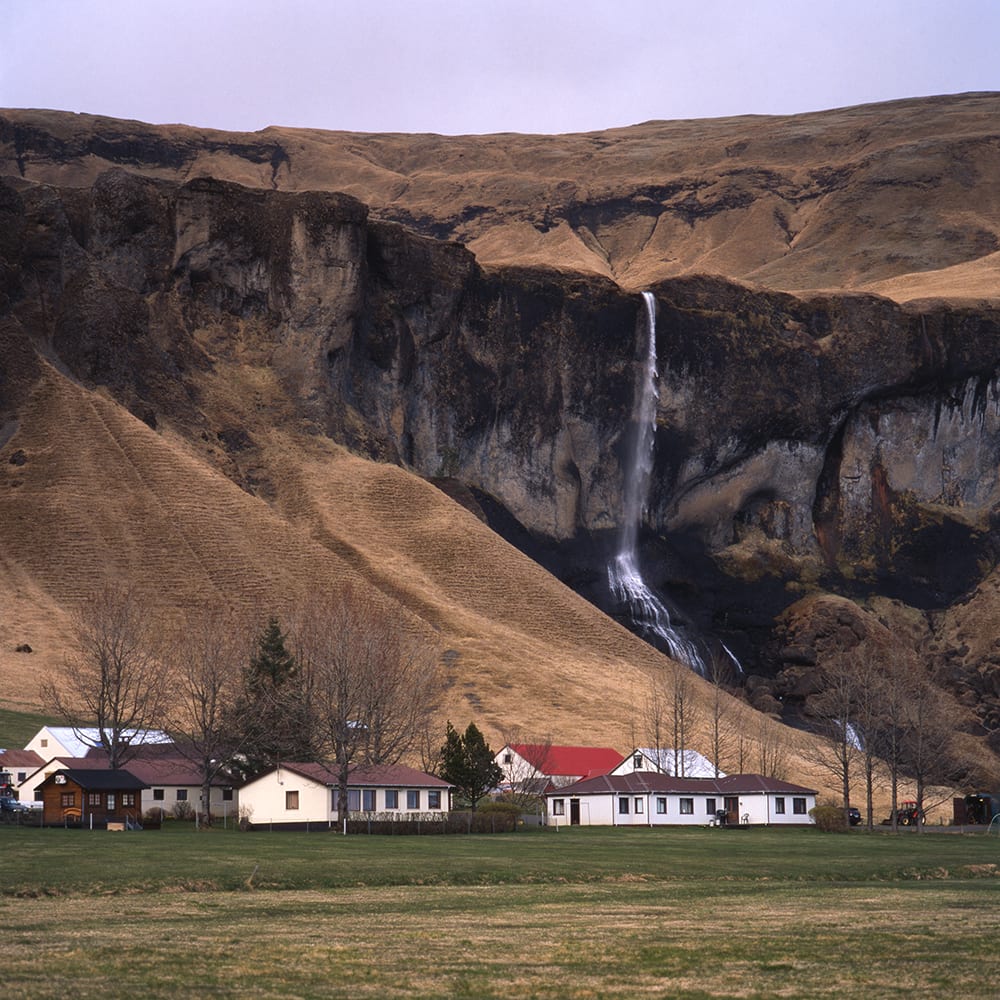
If you are still considering hotels or guided tours for your Iceland trip, let us gently (but firmly) redirect you. Exploring the South Coast in a campervan is like being handed the keys to Iceland itself. Total freedom. Instant access. And no awkward check-in desk conversations (when you’ve heard my level of small talk, you’ll understand how important this is).
Your campervan rental becomes your bed, your breakfast nook, your storm shelter, and your ticket to sunrises over glaciers and midnight rainbows by waterfalls (ahem: Skógafoss). With campsites dotted all along your routes (see the map below – they’re eveyrwhere), staying flexible and spontaneous is part of the fun.
Planning Your South Coast Adventure
How Long Should You Spend Exploring Iceland’s South Coast?
If you are just planning a quick jaunt from Reykjavik to Vík and back, you can easily do it in a couple of days. But honestly, you would be missing out on a hell of a lot of awesome attractions that I’m not even sure I could say you’ve seen the tip of the iceberg of Iceland. That’s why I recommend at least five days to really experience the highlights, and closer to ten if you want to go beyond the crowds and into the good stuff.
A 7 to 10-day south coast itinerary gives you enough time to wander, explore at your own pace, and not feel like you are sprinting past glaciers with a takeaway coffee in hand in one hand and a blurry snap from your iPhone in the other.
When Is the Best Time to Visit?
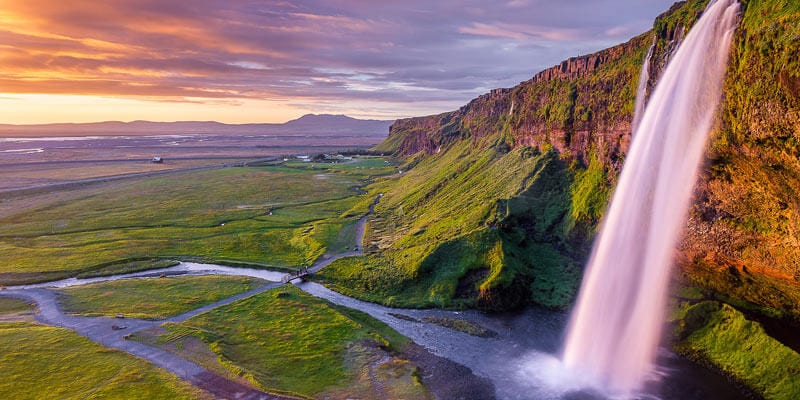
Summer is peak season and for good reason (and sadly not because the temperature rivals that of Ibiza suns). With nearly 24 hours of daylight, you can chase waterfalls at midnight, photograph mountain peaks or glaciers at 3am, and still have time for a roadside hot dog (restaurants do tend to close at this time, so buy your own!) The weather is generally mild, the Highlands are accessible, and road conditions are at their easiest (usualy). But it is also the busiest time of year, so campsites fill up quickly, and popular stops can get crowded.
Spring and autumn, on the other hand, offer a different kind of spice during these so-called shoulder seasons. With the inclusion of darkness you’ll likely disocver golden light over mossy lava field, quieter roads, and more intimate wildlife encounters (the introduction of Puffins in Spring, and farewell of Reindeer in the east in Autumn). The prices drop, the colours pop, and you get the feeling that Iceland is all yours given the smaller number of travellers. Just bring waterproofs and prepare for the occasional moody weather mishap.
Winter travel is perfect with the right gear and experience, but it does require more planning, but not necessarily a 4×4 rental like many forums and blogs can suggest. You can expect icy roads, fewer open campsites, and a slower pace to travelling around (in my opinion, winter is the most unique time to bust your camera out with all of the snow and ice adding to every snap).
However, even with fewer tourists, you’re compensated further with evening Northern Lights displays, and a landscape covered with snow-dusted peaks and frozen waterfalls. Just remember, road closures are common in winter, so flexibility is key and your thermals are your new best friends on any and all wanders.
What to Pack for an Iceland South Coast Road Trip
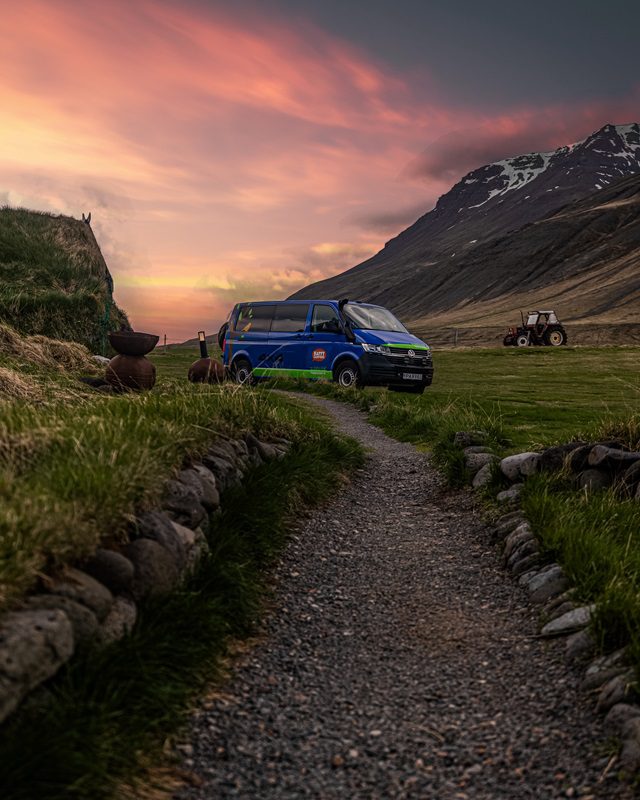
Like I write in basically every travel guide, layers are your best friend. The weather changes faster than Formula One pit teams change tyres, and then some.
You’ll want to dress like a human onion: base layers for warmth, middle layers for insulation, and a waterproof outer layer that can take a punch or two from the infamous sideways rain (and sometimes even snow). Iceland can throw all four seasons at you before lunch, so being overprepared is never a bad idea.
Bring waterproofs, wool jumpers, sturdy boots, a wooly hat that won’t blow off in the wind (as someone who regularly wears a cap…it’s a bad idea), gloves that actually keep your fingers warm, and of course, your sense of humour (in the most blustery of times, this will see you through). A sleep mask helps in summer when the sun forgets to set, and extra snacks are a must for those gloriously remote stretches where sheep outnumber shops, and you’re looking for the closest (and cheapest) option to avoid a holiday domestic.
Power banks, reusable water bottles, and quick-dry towels are also campervan essentials. If you’re cooking on the road, a stash of spices or hot sauce can turn basic meals into culinary victories, and you’re reading from a man who can survive on pasta with pesto for weeks on end (the old phrase of “do as I say, not as I do” comes to mind).
I put together a full Iceland road trip packing list if you are feeling checklisty (or travelling with someone who is).
Tips for Driving and Camping Along the Route

Stick to paved roads unless you are renting one of our 4×4 campervans. Many Highland routes and gravel F-roads are only open during the summer season and require serious ground clearance. If you take a 2WD camper on one of these F-road tracks, not only is it illegal, it’s also a surefire way to get stuck and rack up some hefty repair bills. Plus, Icelandic sheep have enough to deal with without pulling tourists out of ditches. Ok, I’ll be honest, they really just heckle you.
Pay attention to wind warnings (seriously, the wind in Iceland can be crazy). Gusts can reach speeds that will make you rethink opening your van door with any sort of confidence. It’s a good tip to always park facing the wind and hold onto your door like it’s trying to escape if ever you’re caught in a big welcome wind form Mother Nature.
Always check the status of your fuel when passing a petrol station, even if you think you’ve got plenty. Some stretches of the South Coast can be surprisingly remote, and running on fumes while surrounded by glaciers isn’t as cinematic as it sounds. Most N1, Olís and Orkan stations also offer snacks, bathrooms, and surprisingly a decent coffee and hotdog, providing fuel for both you and your campervan.
Use designated campsites, not just because it’s the law, but because they offer actual facilities, WiFi, and fellow travellers to swap photos and travel tips with. Don’t rely on Google Maps to know what’s open; check the campsite’s official site or give them a call if you’re unsure. If you’re coming in summer, they can often be full, so checking in advance is essential during peak season.
Check SafeTravel.is before driving each day. It’s your go-to for road conditions, weather alerts, and travel warnings. Consider it your digital travel buddy, only it doesn’t snore and always knows where the snowstorms are (the spoiler of Icelandic weather, just like my dad and Bond movies I haven’t seen yet).
Day-by-Day Iceland South Coast Itinerary Highlights For a Thorough Exploration
If you’re the kind of traveller who likes to go beyond the highlights, dig into the history, and linger a little longer in each awesome place, then this 10-day itinerary is for you. It’s designed for those who appreciate slow(er) travel and want to truly immerse themselves in Iceland’s natural wonders, charming villages, and lesser-known gems, without feeling rushed or crammed. Perfect for first-timers who want to see it all, returning adventurers looking to go deeper, or anyone who simply believes that road trips should be savoured, not sprinted.
Day 1: Reykjavik to the Golden Circle
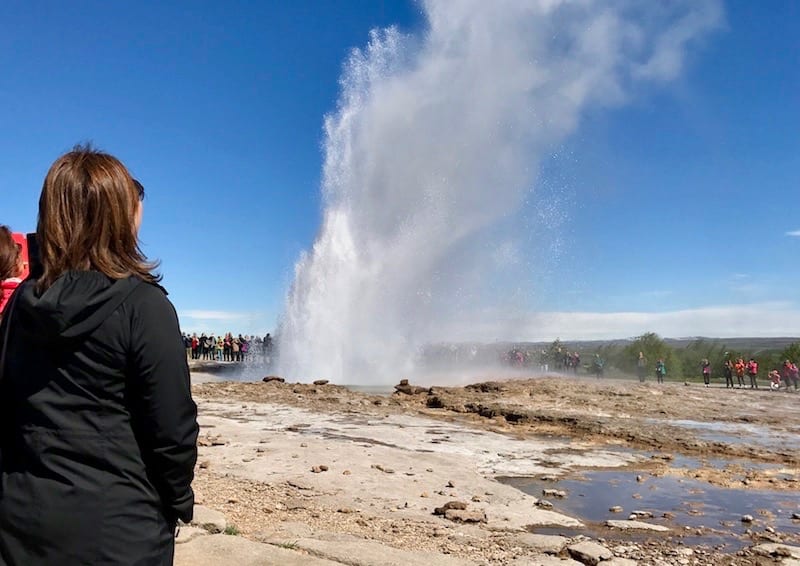
Kick things off with the OG of Iceland travel, the Golden Circle. Thingvellir National Park, where the tectonic plates of the Eurasia and North America drift apart beneath your feet, offers a mix of history and geography that’s hard to beat. Walk through Almannagjá canyon, stand where the world’s first parliament was formed, and if you’re up for it, snorkel between two continents at Silfra.
Next up is Geysir, the geothermal field that gave all geysers their name. Strokkur still puts on a show every 5 to 10 minutes, shooting boiling water skyward like a natural fountain that never quite learned subtlety.
Then you’ll reach Gullfoss, (which translates to ‘Golden Falls’) one of Iceland’s most iconic waterfalls. Stand at the edge as torrents of glacier water cascade over two giant steps and crash into the canyon below. It’s loud, powerful, and will definitely test your waterproof clothing if you go to the lower platform closer to the waters edge.
After a full day of sensory overload, camp near Laugarvatn and wind down with a steamy soak at the Fontana Baths. Let the geothermal heat do its thing while you look out over the lake and wonder if day one peaked too soon (spoiler: it didn’t, this was just the start).
Day 2: Selfoss & Local Culture
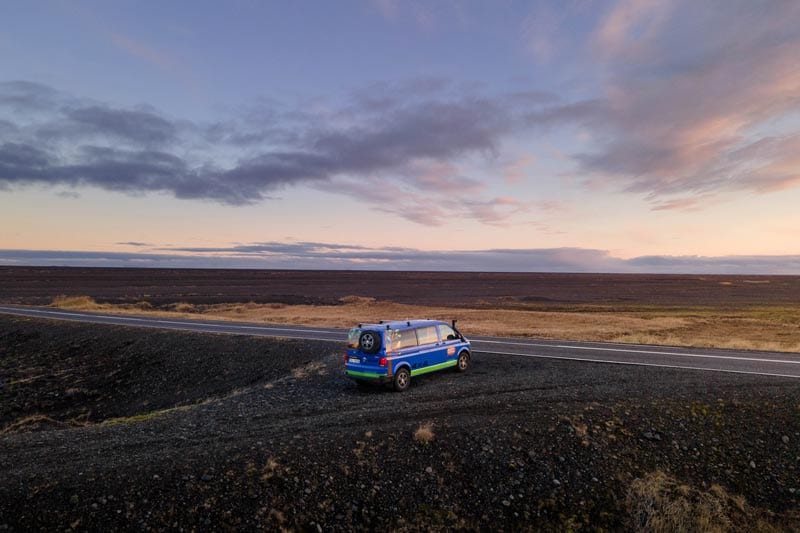
Start the day with a hearty breakfast in Selfoss, a town that’s small in size but big on flavour (and like everywhere in Iceland, it of course has a foodhall). Stock up on groceries, grab a coffee at the local bakery, and if you’re a foodie, dive into the growing restaurant scene, from craft burgers to Icelandic lamb done right (all Icelanders will tell you that Icelandic lamb is the best in the world, just like the Welsh or New Zealanders).
Once you’ve recharged, take a short drive to Urriðafoss, Iceland’s most voluminous waterfall. It might not be the tallest or most famous, but the sheer power of this wide, thundering cascade is something else. Unlike the tourist-packed waterfalls elsewhere, Urriðafoss offers space, solitude, and a raw connection to nature.
It’s a slower-paced day by design, and a welcome pause to recalibrate before the jaw-dropping scenery ramps up again tomorrow and the pullovers start to mount up.
Day 3: Seljalandsfoss and Hidden Gems
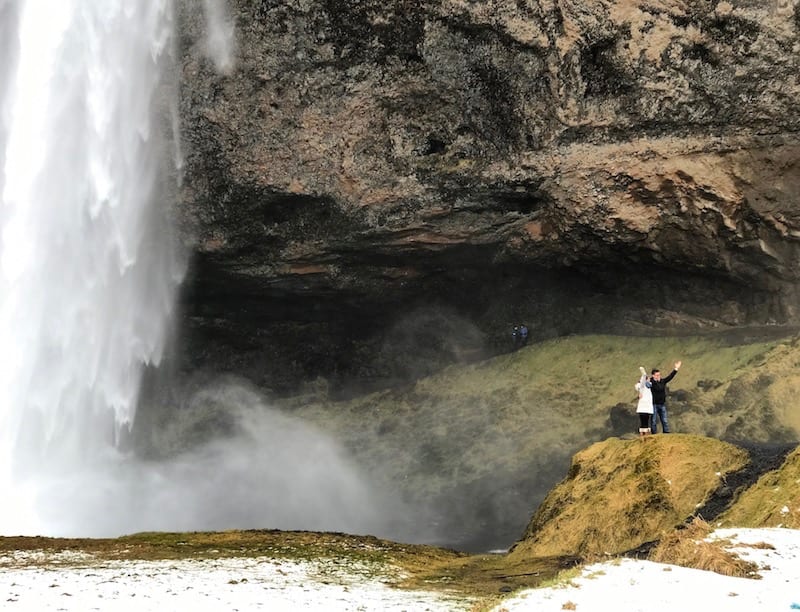
Turn up that TLC and chase waterfalls, but start with the classics. Seljalandsfoss is famous for a reason: you can walk behind the falling curtain of water for a view that’s part fairytale, part shower (pretty sketchy or impossible in winter, however). It’s especially magical at sunrise or sunset when the light catches the mist just right, during the perfect Golden hour experience.
Just a few minutes walk away, sneak off the main trail to find Gljúfrabúi, Seljalandsfoss’s quieter, moodier sibling. Hidden behind a cliff and partially obscured by rock, you’ll need to tiptoe through a stream to get inside, but it’s worth getting a little wet for that mystical atmosphere and awesome snap (if you can keep the water off your camera lens or phone for long enough).
Spend the night at Tjaldsvæðið campsite, perfectly placed for sunset views and an early morning return if you want to beat the crowds. At this campsite you’ll wake up to the thundering sounds of an equally remarkable waterfall, Skógafoss.
Day 4: Skógafoss & Surroundings
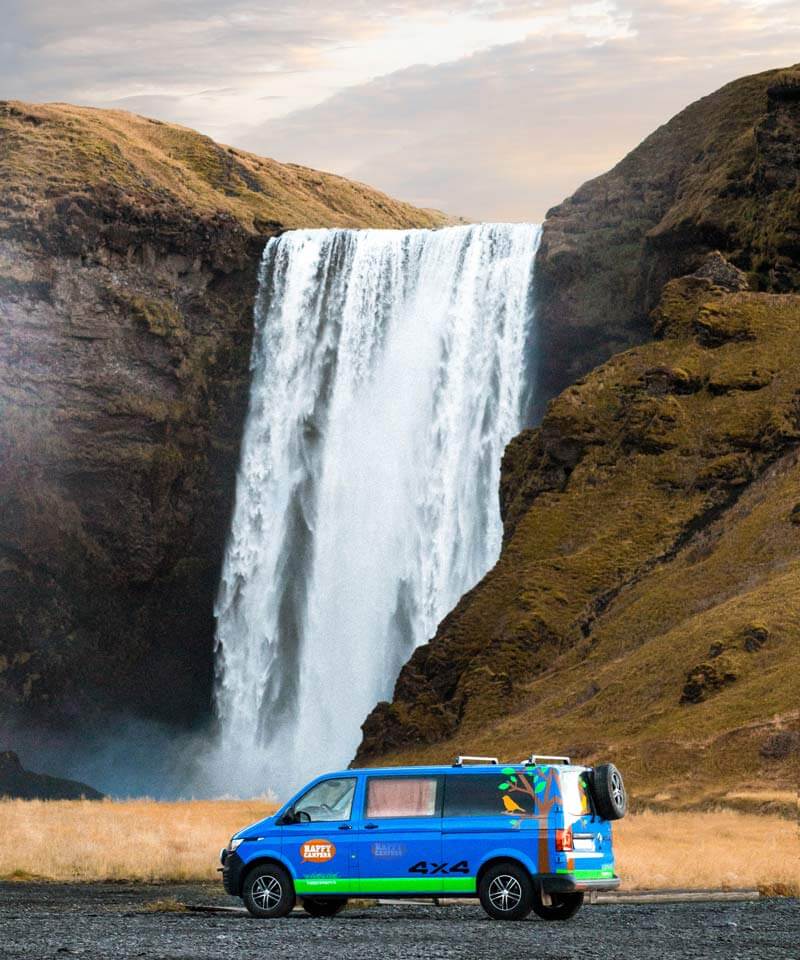
Skógafoss will drench your soul with awe and your face with mist. This towering curtain of water thunders down with such force that it creates its own rainbow on sunny days. Get close enough and you will feel the raw energy of Iceland’s natural power. Be sure to take your time gazing into the curtain of water to see if you can spot the supposed stored treasure of Þrasi Þórólfsson.
Climb the staircase that snakes up the hillside beside the falls for a bird’s-eye view that stretches over the coastline on a clear day. At the top, you can also join the Fimmvörðuháls hiking trail, which is a legendary route into the Highlands connecting Skógar to Þórsmörk. Even if you only do the first kilometre, you’ll pass smaller waterfalls and dramatic canyon views that are well worth the effort.
Don’t miss the Skógar folk museum, one of the best heritage stops in Iceland. It’s packed with turf houses, traditional tools, and insights into how Icelanders once lived, farmed, and fished in this wild environment. Just a short walk away is Kvernufoss, a hidden gem that rivals its famous neighbour but much further away from the spotlight (and travel guides). Tucked in a gorge and reachable by a short path (about 10 minutes and very straight-forward), it’s one of the rare waterfalls you can walk behind, usually without the crowds.
Day 5: Vík & Reynisfjara Beach
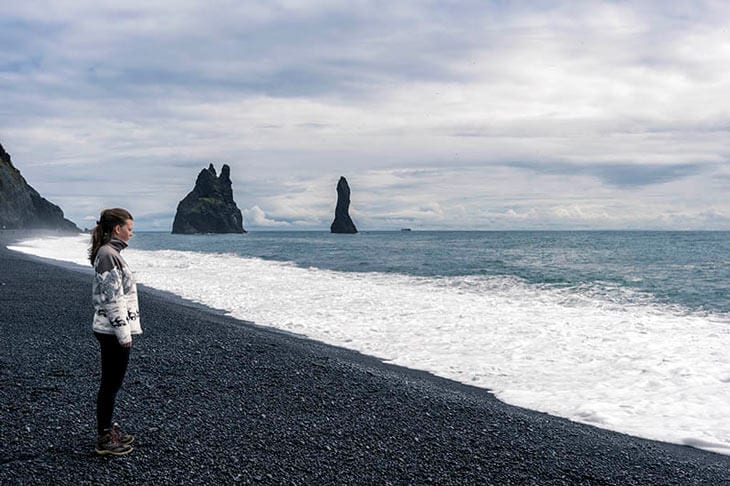
The black sands of Reynisfjara are like something out of a sci-fi film. They’re a mixture of haunting and beautiful, but are also endlessly photogenic. Be cautious though, the waves here are no joke. Known as ‘sneaker waves,’ they can catch even the most careful visitor off guard, and have on times taken the lives of some unsuspected tourists. Make sure you read, check and follow the instructions of the warning signs as you enter the beach and soak in the view safely.
Just offshore, the sea stacks of Reynisdrangar rise like dark sentinels from the sea. According to legend, they are trolls who were turned to stone by the morning sun, which, in Iceland, actually feels plausible enough. Whether you buy into the folklore or not, they make for an incredible backdrop.
A short drive away, Dyrhólaey cliffs offer panoramic views over the coast and, in summer, nesting puffins if you’re lucky. It’s one of those spots where everything (wind, waves, cliffs, and clouds) conspires to blow your mind and your hair (assuming you have some) at the same time.
Vík itself is a charming village nestled beneath a volcanic ridge, and it makes for a great overnight stop. Its well-equipped campsite is walking distance from restaurants, a grocery store, and one of the most photographed churches in Iceland, perched above town with a view that’s pure postcard. If you’re travelling in summer and enjoy photography, take a short walk up the hillside behind the church and sit amongst the lupine plants for that classic shot of the village, the black sand, and Reynsidrangar trolls posing by the distant cliffs.
Day 6: Fjaðrárgljúfur Canyon
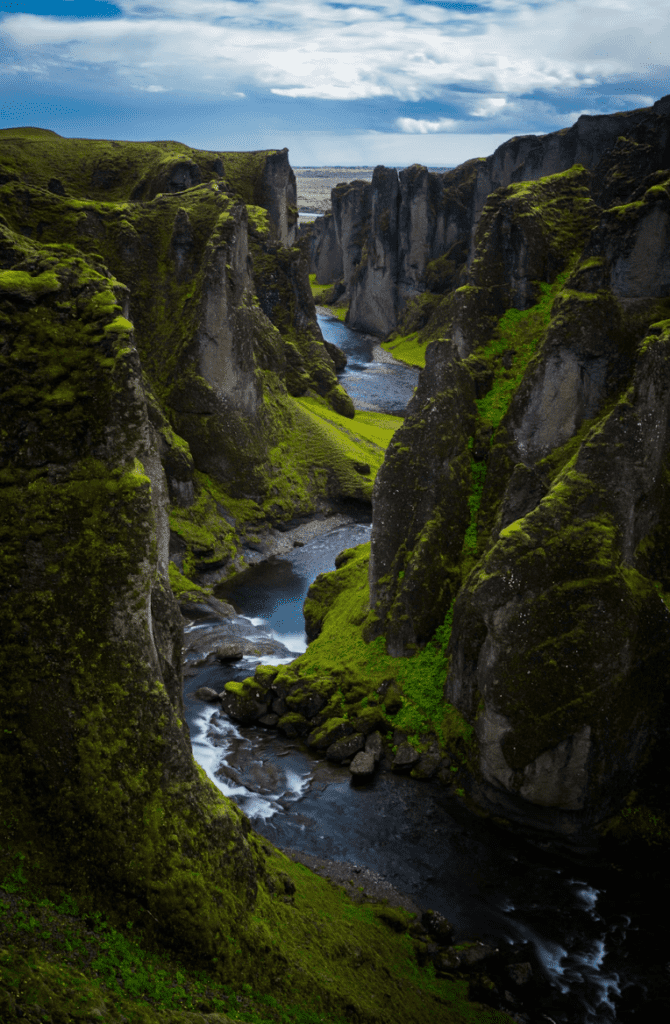
A mouthful to say, a masterpiece to visit. Fjaðrárgljúfur is a twisting green canyon carved by glacial meltwater over thousands of years, with sheer moss-covered walls and a river that winds like a ribbon through its base. Not only is it scenic, it’s also cinematic, having famously featured in Game of Thrones and even a Justin Bieber music video (you decide which one tempts you to visit more).
A short walk from the car park leads you to several stunning viewpoints, and if conditions allow, you can follow the trail along the edge for panoramic views that feel almost too perfect to be real. Bring a camera, sturdy shoes, and don’t rush your time here. Stay on the paths and look out for dragons.
Day 7: Skaftafell & Vatnajökull National Park
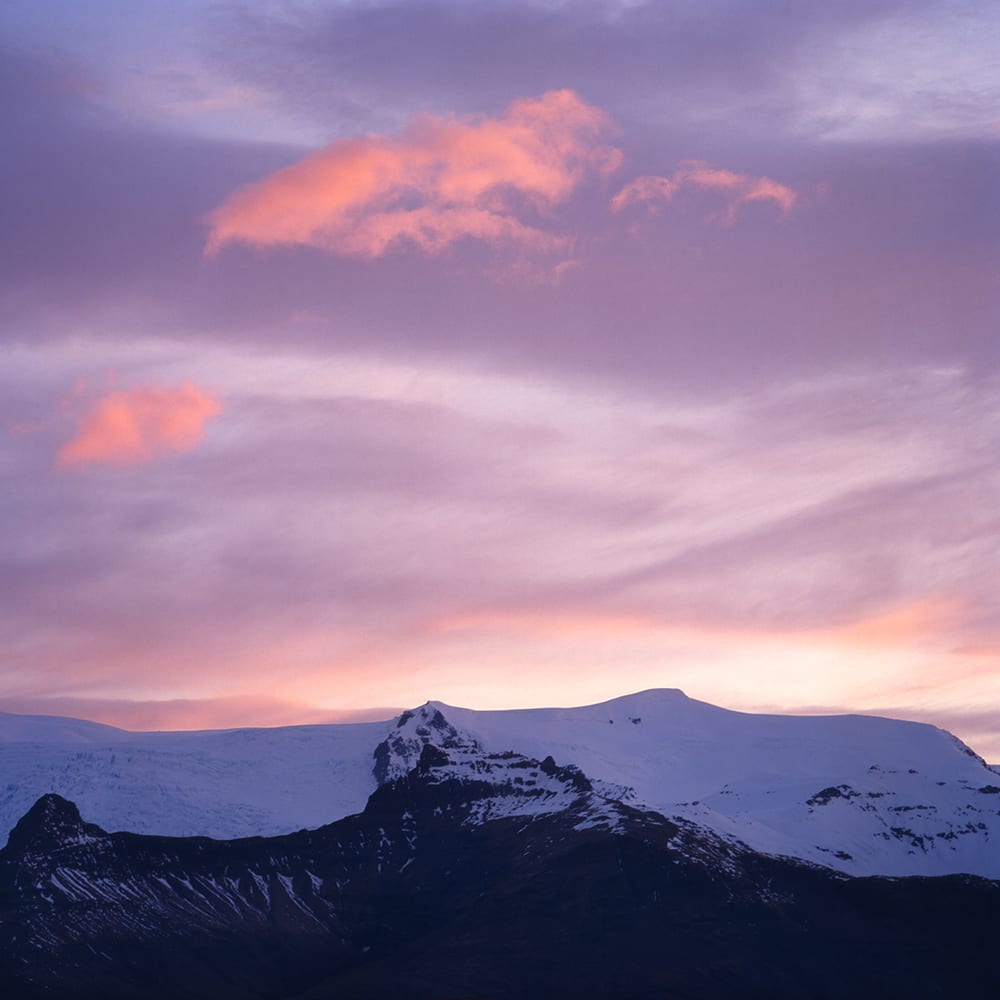 Pink skies at night in Skaftafell
Pink skies at night in Skaftafell
Glacier hikes that take you onto ancient ice, mountain views that stretch endlessly across Vatnajökull National Park, and campsites crafted by real-life Instagram filters, I give you Skaftafell, the kind of place that makes sure you get the value out of your pre-holiday purchasedhiking boots.
The area offers trails for all abilities, from easy strolls to Svartifoss, a stunning waterfall framed by black basalt columns, to more demanding hikes that lead up to viewpoints over sprawling glacier tongues and sweeping valleys carved from the thawing of the last ice age.
Whether you are here for a morning wander or a full-day trek, Skaftafell delivers unforgettable landscapes with every step. And after all that walking, there’s nothing better than a quiet night at the nearby campsite with the glow of the midnight sun or northern lights dancing above your campervan.
Day 8: Glacier Adventures
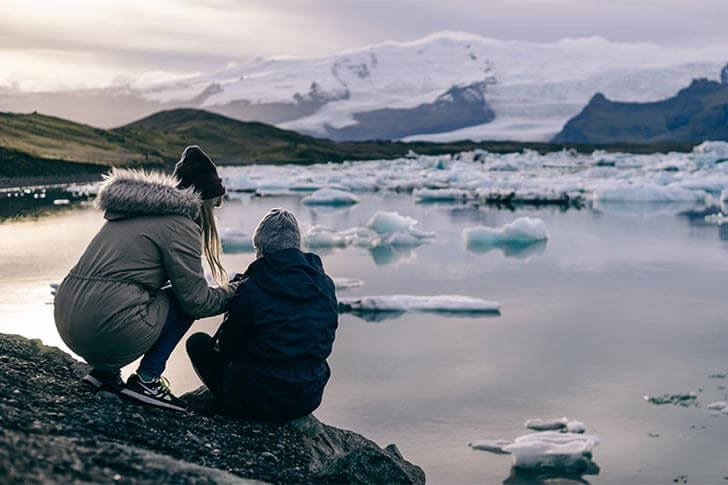
Book a blue ice cave tour from Jökulsárlón or a glacier hike from Skaftafell for a couple of bucket list checks. These wild experiences plunge you into the heart of Iceland’s glacial landscapes, where electric-blue ice walls, frozen caverns, and creaking glacial tunnels transport you to see and hear the inner workings of one of natures last remaining melting giants. Whether you opt for a winter-only ice cave tour (insider info: you can visit Katla ice cave near Vík all year round) or a year-round glacier hike, you’ll be walking where the earth breathes ice.
It’s cold. It’s wet. Your boots will complain, and your camera lens might fog up. But the sheer scale and silence of these icy cathedrals will leave you speechless. Guides provide crampons, ice axes, and all the necessary equipment, and they know these shifting giants like the back of their frostbitten hands, so trust me, you’re in good company.
If there’s one splurge I’d reocmmend on your South Coast journey, make it this. Climbing onto a glacier or visiting a natural frozen ice cave or not something everyone gets the chance to experience. It’s as stunning and exerting as it is retrospective, in my experience.
Day 9: Jökulsárlón Glacier Lagoon & Diamond Beach
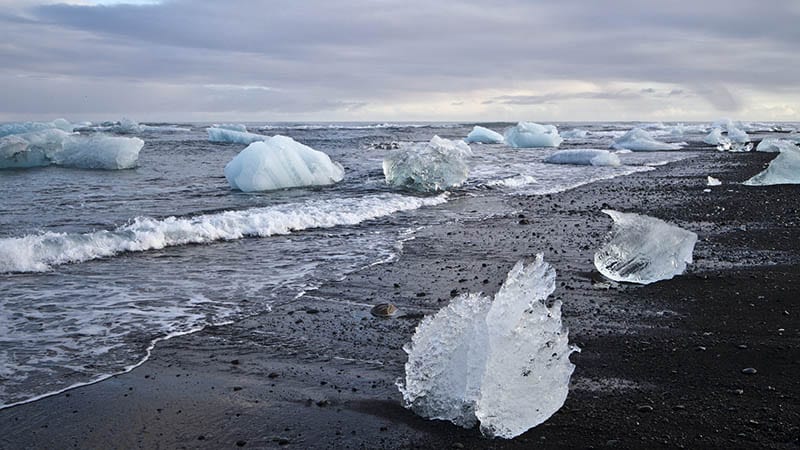
This day starts with icebergs floating like sleepy giants, slowly drifting through Jökulsárlón Glacier Lagoon as they crash into each other and very daintly make their way out to the open seas (or so you think). You might get lucky and spot seals snoozing on the ice, occasionally slipping into the water with a splash that breaks the stillness. Above it all, snow-capped peaks watch silently as the icy waters glisten in the low Arctic light. If you take a Zodiac boat tour out into the waters, you’ll get to see the titanous wall of their glacial tongue and hear the creaks as chunks of ice fall of it (it can cause some crazy waves).
Just across the road, the famous Diamond Beach stretches out, comprising a black sand shoreline littered with glistening shards of ice, varying in size and magnitude, that look like they’ve spilled from a glacier’s jewellery box. Some pieces sparkle like cut glass, others glow blue like frozen sapphires. It’s a surreal contrast that feels dreamlike, providing plenty of opportunity for pictures. Just don’t sit on the ice. The currents are strong here and you wouldn’t be the first person to be whisked out to see!
Day 10: Vestrahorn & the East
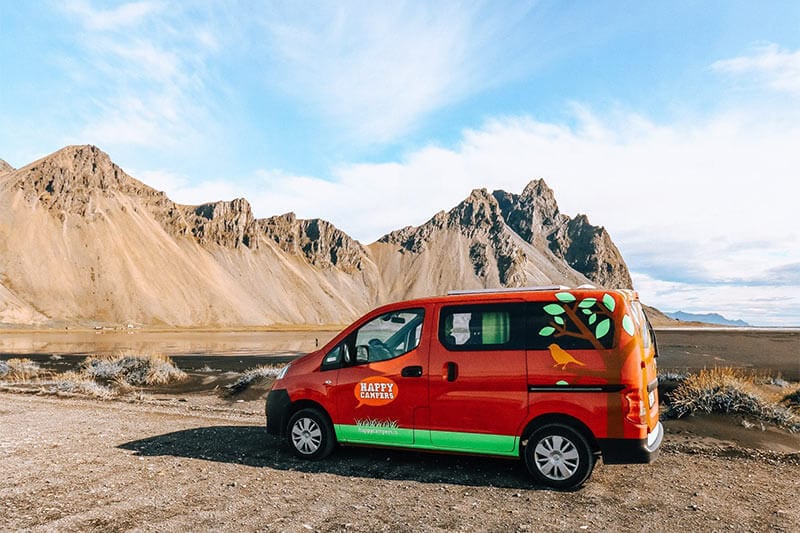
Next, you’ll drive to Vestrahorn, one of Iceland’s most photogenic and dramatic mountains, which although holds an entry charge (a bit crazy), the added walk through a Viking Village (originally made for a TV show that never happened) does make for one of the more unique rambles I’ve taken in Iceland. Rising like a jagged crown from a black sand beach near Höfn, its sharp peaks and mirrored reflections in the shallow tidal flats make it a photographer’s paradise, especially at sunrise or sunset, when the colours dance across sky and sand alike.
It’s less visited than the better-known Golden Circle stops, which means you’ll likely share the landscape with only a handful of shutterbugs which is always ideal when snapping away. The windswept terrain here feels primal, with the ocean on one side, dunes a little further out, and dramatic mountains towering overhead.
Take your time to walk along Stokksnes beach, and consider grabbing a coffee at the Viking Café nearby. This is your farthest point east before heading back or continuing your loop into the wild beauty of the Eastfjords. It’s a perfect send-off from the South Coast’s spellbinding stretch, and a good way to mark to entry to both regions.
Exploring Iceland’s South Coast in 3 Days
Pressed for time but still eager to soak up Iceland’s south coast best bits? This 3-day itinerary is designed for travellers who want to maximise their south coast experience and are willing to sacrifice a sandwich stop for an extra hike or wander.
Ideal for spontaneous long-weekend adventurers, stopover visitors, or vanlifers combining this leg with other regions of Iceland, this route is fast-paced but still unforgettable. You’ll see the highlights, skip the fluff, and discover just how much wonder can fit into three well-planned days. I’d say this enough time to see many things, but will mean you need to be a lot more military in your planning which isn’t for everyone (cough: me!)
Day 1: Reykjavik to Vík
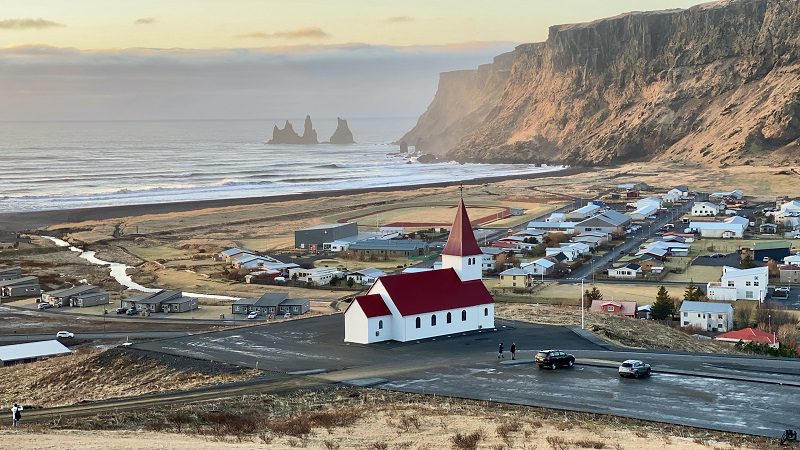
Start early and make your way through the Golden Circle if you want a quick sampler of Iceland’s geothermal and geological wonders before heading south. Thingvellir’s tectonic drama, Geysir’s bubbling showmanship, and Gullfoss’s sheer power offer a stunning prelude to your coastal adventure. If you choose this option, plan for a full and rewarding day, ending in the southern lowlands before settling into your first campsite.
Alternatively, if you prefer to head straight to the southern coastline, focus your day on two of Iceland’s most iconic waterfalls: Seljalandsfoss and Skógafoss. Walk behind Seljalandsfoss’s misty veil and climb the stairs beside Skógafoss for views over farmlands and mountains. If you’ve got time, sneak in a visit to Gljúfrabúi or Kvernufoss with quieter cascades nearby.
End your day in Vík, where the nearby black sand beach and dramatic sea stacks offer a moody, magical sunset. This route gives you a cinematic start without rushing your first day too much, setting the tone for an unforgettable road trip (this drive is only around 2.5 hours in total also).
Day 2: Vík to Jökulsárlón Glacier Lagoon
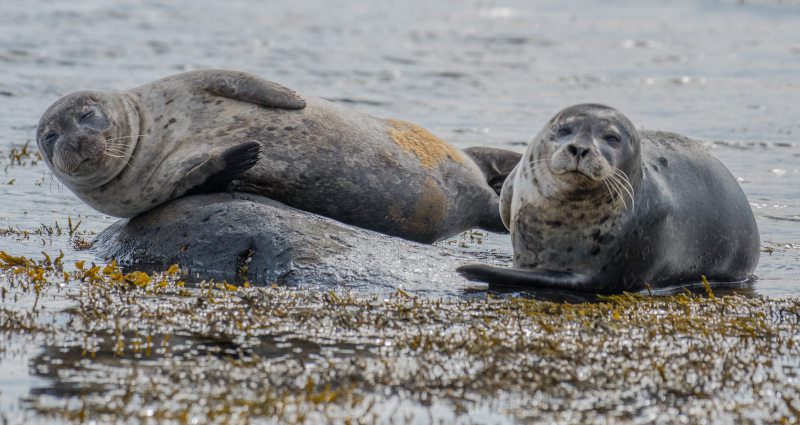
Tick off Reynisfjara beach, with its moody black sands and roaring waves, and wander along Dyrhólaey’s cliffs for sweeping coastal views and a chance to spot puffins nesting in the summer. Then make your way through the winding trails of Fjaðrárgljúfur canyon, carved for the dragons of Daenerys.
Next, head east to Skaftafell for your first glimpse of glacier country where you can start by walking trails that let you stretch your legs among waterfalls and ice. With an early enough start, you can squeeze in a short guided glacier hike to get up close with these ancient ice formations.
Wrap up your day by the luminous Jökulsárlón Glacier Lagoon. Watch the icebergs drift and catch the last light at Diamond Beach across the road, where fragments of glacier sparkle like gemstones on black sand, providing a dramatic finale to an unforgettable day.
Day 3: Jökulsárlón Glacier Lagoon to the Eastfjords or Back to Reykjavík
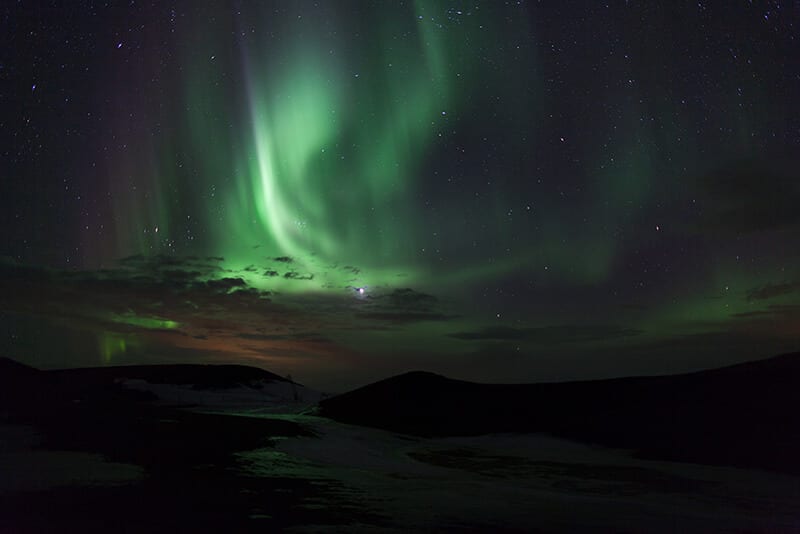
Spend your morning soaking in the serene beauty of icebergs drifting through Jökulsárlón and the shimmering black sands of the famous Diamond Beach, where you can start to understand the ice in Iceland’s nickname as the land of fire and ice. If your wanderlust isn’t quite satisfied, continue your journey into the quiet Eastfjords, where winding coastal roads, sleepy fishing villages, and reindeer herds await (if you’re visiting in late Autumn/early winter). It’s a region less travelled due to it’s proximity from city life, which will give you even more space for adventure.
Alternatively, begin your return westward with fresh eyes and new detours. Revisit favourite stops like Vík for one last look at the sea stacks or Seljalandsfoss if you missed the behind-the-falls photo op. You could also take a longer stop-off in Selfoss if you’re a foodie, as it’s a perfect place to unwind with local food, a hot shower, and reflections on your adventure. However you choose to end your south coast journey is up to you, and both and right.
10 Secret Iceland South Coast Spots & Scenic Detours
1. Gluggafoss: The Window Waterfall
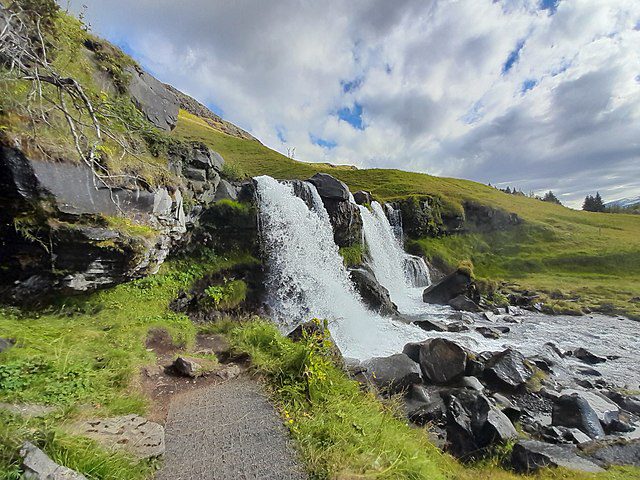 Photo Credit: Hornstrandir1 via Wikimedia C.C.
Photo Credit: Hornstrandir1 via Wikimedia C.C.
Hidden in the Fljótshlíð area, this lesser-known waterfall features natural ‘windows’ in the cliff that the water elegantly flows through, creating a rare and beautiful visual effect. Surrounded by peaceful farmlands and dramatic hills, it feels like a fantasy film set without the film crew or crowds (at the time of writing that is. I expect a film soon!) The sound of rushing water echoes gently through the canyon, adding to the setting. It’s a perfect quick detour for those craving serenity and cinematic scenery in equal measure well away from other travellers.
2. Nauthúsagil Ravine
A mossy slot canyon near Seljalandsfoss with a narrow, winding path, small climbs, and trickling waterfalls lining the walls. The hike requires some scrambling over slippery rocks and stepping through shallow streams, so wear waterproof shoes and prepare to get a little wet. There are also some chains you’ll need to grapple onto as you get closer to the main waterfall within, so conversely to many other travel guides I’ve seen, this one is for fit adults, not children (I just saved some of you from a waterlogged tantrum). Channel your inner elf and let curiosity guide you through the green, glowing gorge.
3. Þakgil (Thakgil) Canyon
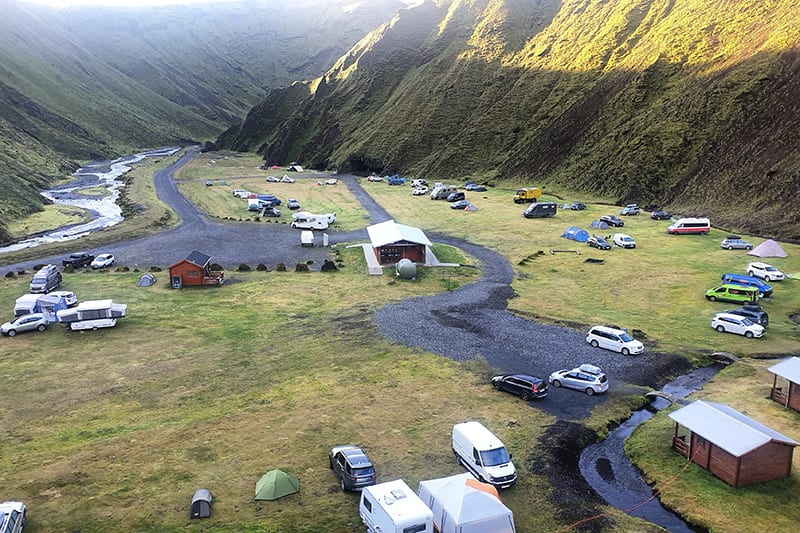
An epic detour off the main road near Vík, Þakgil (or Thakgil) is a sheltered canyon cradled between rugged cliffs and lava formations that make you feel like you’ve landed on another planet, which is the general theme at cool locations in Iceland. The road there alone is an adventure, winding through dramatic volcanic landscapes before arriving at a hidden haven of mossy tranquillity. The campground is one of the most unique in Iceland, nestled deep in the canyon with a cave that serves as a communal dining area, and is popularly the favourite of our Happy Camper team.
The hiking here is spectacular, with trails leading to panoramic viewpoints over Mýrdalsjökull glacier and beyond. Þakgil is ideal for those seeking something more off-grid, atmospheric, and unforgettable. If you’re craving stillness with a side of volcanic drama, this is your place.
4. Hjörleifshöfði & The Yoda Cave
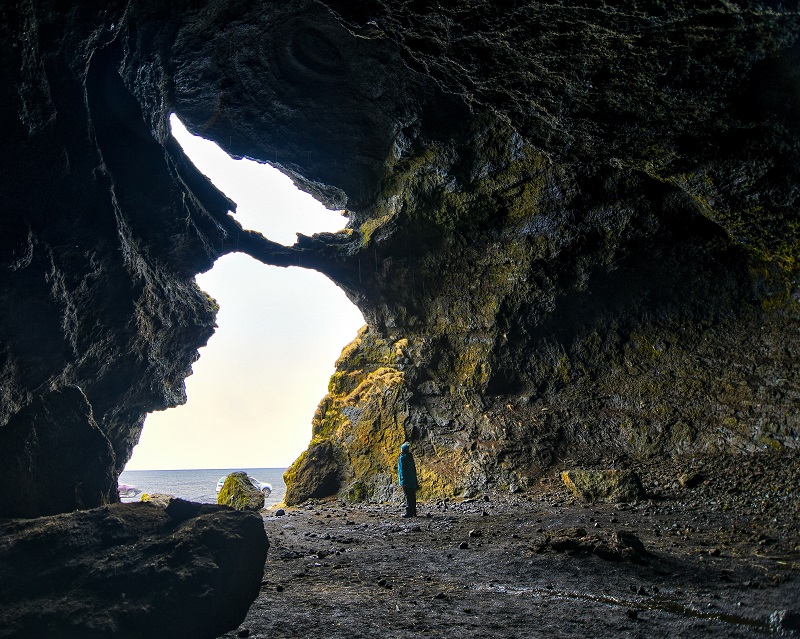
Yes, there’s a cave shaped like Yoda’s head, and yes, it really does look like him, but it’s absolutely massive! It’s a short and manageable hike that rewards you with not only the novelty of pop-culture-shaped geology, but also sweeping coastal views and a sense of eerie solitude. The whole Hjörleifshöfði promontory feels steeped in old legends and quiet drama, where every rock seems to have a story and the sea whispers just out of sight. Bring a windbreaker, and maybe a lightsaber (better if you’re here on May 4th, of course).
5. Dverghamrar: The Dwarf Cliffs
 Photo Credit: JD554 via Wikimedia C.C.
Photo Credit: JD554 via Wikimedia C.C.
A striking cluster of hexagonal basalt columns said to be inhabited by dwarves, and with Icelandic folklore, who’s to say they’re not (other than me)? The geometric formations are a natural marvel, rising like the organ pipes of some ancient lava cathedral. It’s an easy roadside stop that offers a great chance to stretch your legs and snap a few photos of nature’s architecture. The location is also steeped in legend and local history, adding a touch of mystery to the already enchanting landscape.
6. Laufskálavarða Lava Ridge
Tradition says you build a cairn here for luck before crossing Mýrdalssandur, which is a vast, black sand desert shaped by glacial floods and volcanic activity. Over the years, travellers have added their own small stacks of stones to the lava field, creating a whimsical landscape of miniature towers. It’s an oddly peaceful stop, where ancient superstition meets quiet reflection. Whether you’re superstitious or not, there’s something grounding about placing your own stone and soaking in the wide-open views.
7. Kálfafellstaður Church & Turf Farm
One of the few places where you can see traditional Icelandic turf architecture up close along the south coast. The farm and church offer a rare glimpse into the past, showcasing the kind of sustainable, earth-insulated buildings that once dotted the Icelandic landscape. The turf-roofed structures blend seamlessly into the surrounding fields, evoking a sense of timelessness and quiet resilience. It’s a peaceful and educational stop for those interested in Iceland’s rural heritage and architectural ingenuity.
8. Systrafoss: The Twin Falls of Kirkjubæjarklaustur
 Photo Credit: Bromr via Wikimedia C.C.
Photo Credit: Bromr via Wikimedia C.C.
Easily missed, this pair of waterfalls is tucked into a cliff behind the village of Kirkjubæjarklaustur. Known as Systrafoss, or the Sisters’ Falls (maybe doing it for themselves), they gently cascade down in parallel, creating a peaceful and symmetrical sight framed by trees and moss-covered rocks. A walking path leads from the base up to Systravatn, the ‘Sisters’ Lake’ above, offering panoramic views over the village and surrounding countryside. It’s a serene stop that combines folklore, natural beauty, and a rewarding short hike. It’s also a great, and well-earned, break on the drive from Vík to Skaftafell.
9. Foss á Síðu
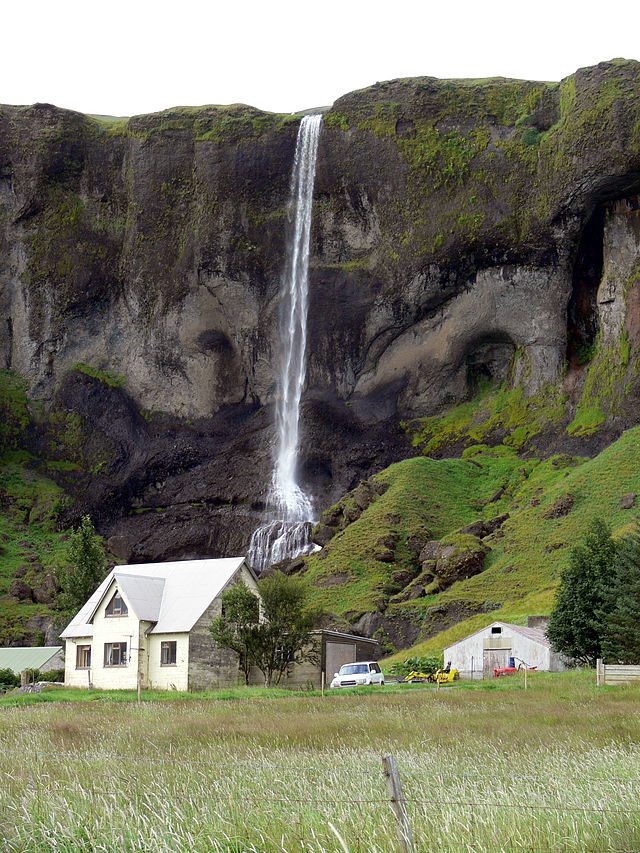 Photo Credit: Christian Bickel via Wikimedia C.C.
Photo Credit: Christian Bickel via Wikimedia C.C.
A waterfall that cascades down a sheer cliff face and sometimes gets blown sideways by the wind is a spectacle of nature’s unpredictability, Iceland-style. Foss á Síðu isn’t one of the tallest or loudest falls, but its elegant ribbon of water dancing in the wind against a dramatic basalt backdrop creates a unique beauty. It’s a favourite for photographers and daydreamers alike, especially when mist swirls and light filters through the spray, turning a simple roadside stop into a pretty cool scene.
10. Fjallsárlón Glacier Lagoon
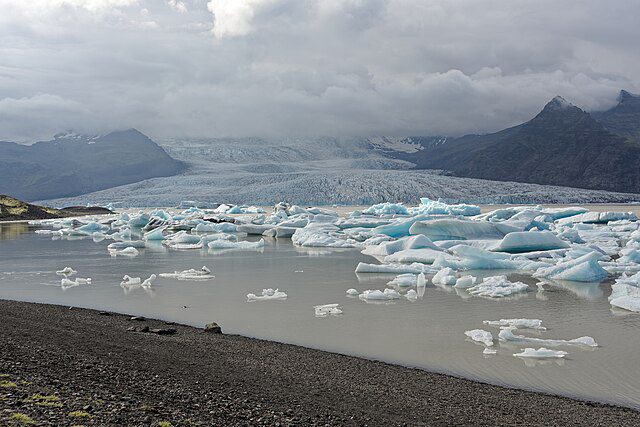 Photo Credit: Jakub Hałun via Wikimedia C.C.
Photo Credit: Jakub Hałun via Wikimedia C.C.
The quieter cousin of Jökulsárlón, Fjallsárlón Glacier Lagoon offers boat tours among floating icebergs with fewer crowds and more tranquil surroundings. Peaceful viewing platforms provide a front-row seat to the calving face of the Vatnajökull glacier, where shimmering chunks of ice drift slowly across the still water. It’s the perfect place to bring a snack, sit back, and take in the majesty of Iceland’s frozen heart in contemplative silence (kind of, there is also a sizeable service stop here with a car park that assumes people have heard about it, so maybe have a word with their marketing team while you’re there). Early mornings or late evenings are especially magical, when the light softens and the lagoon feels like a hidden dreamscape.
Wildlife & Nature Along the South Coast
Iceland’s south coast isn’t just a playground of fire and ice, it’s also home to some of the country’s most diverse and accessible wildlife experiences. From seabirds perched on sea cliffs to seals lounging on drifting ice (and a Walrus or two, if you’re particularly lucky), the route offers plenty of opportunities to connect with the animal kingdom. You won’t find any zoos out here, just a pre-Arctic tundra of free roaming local creatures (although, the Reindeer do originally come form Norway and are not remotely indigenous to Iceland).
Puffin Viewing Spots in Summer

From May to August, puffins return to Iceland’s coastlines to nest along dramatic cliff edges and sea stacks. The best places to spot them on this stretch (without a time-consuming detour) are Dyrhólaey, where you can look out over a puffin-packed promontory, and the cliffs west of Vík, which offer a quieter, less crowded alternative with equally charming views.
These charismatic seabirds are instantly recognisable with their bright orange beaks and cartoon-like expressions which is why they are known as ‘the clowns of the sea’. You’ll know you’re in the right spot when you see long-lensed cameras clicking and tourists squealing with delight as puffins swoop overhead or waddle clumsily to their burrows with a mouth full of fish.
Where to See Seals and Arctic Terns
Jökulsárlón Glacier Lagoon is a fantastic spot for watching seals lounge on floating icebergs or bob through the icy water with curious glances. They often pop up close to the shoreline, offering great photo opportunities without needing binoculars. Meanwhile, Arctic terns (small, fierce, and fiercely territorial, much like mother-in-laws) dominate the skies in summer. These aerial acrobats migrate thousands of miles each year, only to spend their nesting season guarding patches of Icelandic gravel like it’s Fort Knox.
If you accidentally wander too close to their nests, expect a dramatic dive-bomb performance. Walk briskly, look apologetic, and maybe mumble a respectful “Sorry” as they squawk above your head.
Keeping an Eye Out for Reindeer in the East
As you venture east of Höfn (and I’ve seen them as close as Jökulsárlon in winter), keep your eyes peeled for wild reindeer herds. It’s a rare sight elsewhere in Iceland but more common in this region. Summer offers the best chance to spot them as they graze the open fields and meander across quiet roads near the Eastfjords. These shy yet majestic creatures often blend into the backdrop, their antlers rising like branches from the mossy terrain. And if you’re lucky, they might just wander into frame and photobomb your otherwise glacier-focused shot, adding a touch of wildlife magic to your road trip reel. I once rushed to stop to photograph four reindeer standing like the Abbey Road album, to turn the corner and see hundreds…
Top Camper Tips for the South Coast
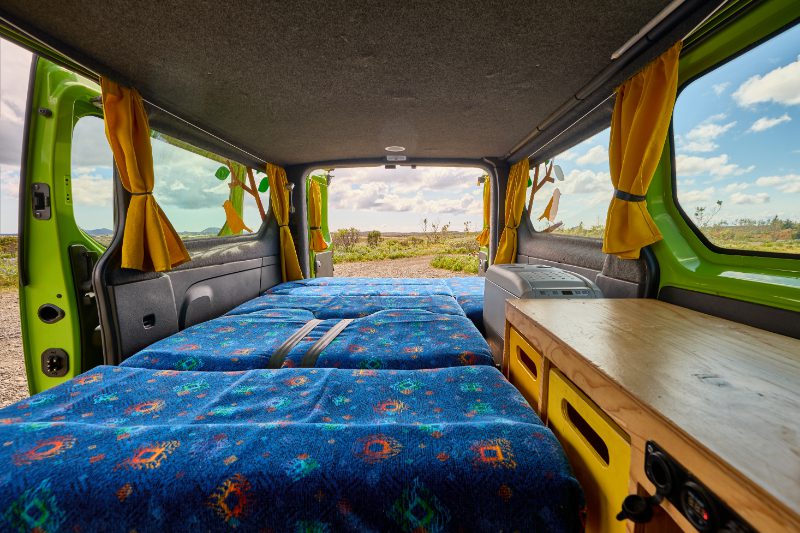
Whether you’re tackling this epic road trip for the first time or you’ve already been enchanted by Iceland’s wild south once before, it pays to have a few insider tips up your sleeve. This section is your shortcut to making life on the road easier, safer, and a whole lot more enjoyable, with practical advice tailored to our fellow vanlifers. From campsite strategy to dealing with Iceland’s mood swings in weather, here’s how to make the most of your journey without falling into the usual tourist traps.
Best Campgrounds Along the Route
Skógar, Vík, Skaftafell, and Jökulsárlón are your main go-to spots, not just for sightseeing, but for settling in for the night with some of the best camping views in the country. Each location offers nearby campsites that cater to campervans, often featuring well-maintained amenities like cooking shelters, toilets, hot showers, and scenic surroundings that make your overnight stay part of the adventure.
Whether you’re falling asleep to the roar of a waterfall or waking up next to the shine of a glacier with your coffee in hand, these campgrounds give you access to nature without sacrificing comfort.
Check out our favourite campsites with honest reviews, what to expect, and insider tips on which ones fill up fast, as well as which ones are worth that extra drive.
Staying Safe in Changing Weather
Always check vedur.is for up-to-date forecasts before setting off which is pretty essential in this fickle land of weather we call home. The weather on Iceland’s south coast is notorious for its rapid shifts, especially wind, which can gust strong enough to knock you off balance or give your campervan a strong nudge on the roads.
Storms can roll in faster than your mobile data refreshes, bringing sudden whiteouts, sideways rain, or surprise snow flurries even in early summer. If the locals are pulling over, you probably should too, after all their instincts are honed from years of navigating these wild conditions (and regularly checking the forecast). Icelanders are so connected to the weather that even with their personal plans they’ll regularly say “Fer eftir veðri” (it depends on the weather) to their friends and family.
Keep an eye on wind speed warnings in particular, and don’t underestimate how dramatically the weather can change between valleys and mountain passes. Park smart, dress warm, and when in doubt, wait it out.
Finding Fuel, Food, and Facilities
Fuel up in bigger towns like Selfoss, Vík, and Höfn, especially before venturing into more remote stretches of the south coast. Petrol stations such as N1, Olís, and Orkan often have 24/7 pumps, warm food options, coffee, WiFi, and of course, bathrooms. They’re great spots to top up your tank, grab a quick meal, and stretch your legs while surrounded by dramatic Icelandic landscapes (if you stop Hvöllsvollur, across the street from the Nesti station is a great ice cream stop called Valdís).
When it comes to stocking your camper pantry, grocery stores like Bónus and Krónan are your budget-friendly heroes. Bónus (look for the yellow pig logo) tends to have the lowest prices, while Krónan offers a slightly wider selection, including more health-conscious and specialty items. Both are well-distributed across towns and ideal for stocking up on snacks, meals, and anything else you forgot. Just note that opening hours can be limited in smaller towns, especially on weekends, so plan your shopping stops accordingly. And, if you fancy grabbing a bottle of wine or a few cans of beer for the evening, make sure you stop off at the local Vínbúðin in most towns along the south coast.
Responsible Camping & Leave No Trace

Stay on marked roads and only use designated campsites, it’s not just the law, it’s the right thing to do. For instance, Iceland’s delicate moss takes decades to regrow, and tyre tracks or trampling can leave scars that last a lifetime. Park responsibly, even if you’re only stopping for a quick photo.
Keep your rubbish with you until you can dispose of it properly, and if you see litter, consider picking it up (karma points from me to you). Small actions like these help preserve Iceland’s natural beauty for the next traveller. Follow Iceland’s camping laws, and try to leave every place the same as you found it. After all, elves have long memories, and if you read much of the folklore, they also love revenge!
Conclusion
Exploring the south coast of Iceland by campervan is a bit like having the cheat code for nature.
You get to fall asleep next to waterfalls, chase rainbows through mossy canyons, and sip a coffee while watching icebergs drift silently by, all without unpacking a suitcase.
From the famous spots to the tucked-away treasures, this stretch of road delivers the kind of moments you will talk about for years. And with your Happy Campers campervan, you get to experience them all on your own terms.
So stock up, fill your tank, cue the playlist, and hit the road. The south coast is calling.
Book your camper today and start your Icelandic story the way it should be told: freely, wildly, and wonderfully unplanned.
Back